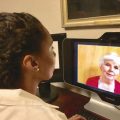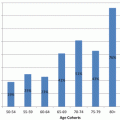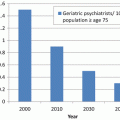Fig. 1.1
This figure gives a pictorial representation of the relationship between telepsychiatry, telemedicine, and telehealth. Telepsychiatry represents the application of telemedicine to psychiatric care while telemedicine sits under the umbrella term of telehealth
1.3 Brief History of Telepsychiatry
The application of two-way interactive videoconferencing to psychiatry dates back to the 1950s. In 1956, Wittson and Dutton described their experience at the Nebraska Psychiatric Institute where closed-circuit television was utilized primarily as a teaching tool. The equipment employed included an audiovisual system consisting of three cameras, three 17-inch monitor-receivers in a control room, a receiver-projector in an auditorium, and a six-by-seven foot projection screen also in an auditorium. The entire system costs approximately $18,000 and in order to function, required a full-time electronics technician, a part-time television programming coordinator, and a part-time medical electronics consultant. The equipment was used mainly to provide demonstrations to trainees in psychiatry but also served other purposes including allowing nursing staff to monitor patients remotely [6].
In 1961, this same system was applied to providing group psychotherapy at the Nebraska Psychiatric Institute. Patients were gathered in a group room and arranged in a V formation to allow unencumbered view of the television by all patients. A camera was mounted atop the television providing the therapist a fixed view of the group. The authors report that participants appeared interested and voiced no major concerns. They demonstrated successful use of this medium to provide group psychotherapy with one exception; one group containing three individuals with anti-social behavior resorted to whispering in an attempt to exclude the therapist from group discussions [7].
In 1971, Solow et al. described their experience with two-way closed circuit television at Dartmouth Medical School in Hanover, New Hampshire. Here, psychiatrists at the academic medical center provided psychiatric consultations to residents of Claremont, New Hampshire, a town of approximately 13,000 residents located in a rural county 26 miles from the academic center. This program was designed to provide access to psychiatric care as there were no psychiatrists and only 21 family physicians in the entire county. Almost 200 remote consultations were successfully completed, each lasting about 50 min [8].
Despite application of two-way television to psychiatric care as far back as the 1950s, the term telepsychiatry was not coined until 1973. At this time, Dwyer employed this term to describe the use of interactive television at Massachusetts General Hospital to provide psychiatric consultations to Logan International Airport Medical Station. One of the benefits of this assessment and treatment modality was elimination of travel time, allowing increased access to a greater number of patients. Patients from a variety of settings were assessed including consultations with probation officers charged with care of troubled youth, junior high school students, and inmates in correctional settings. The system also facilitated staff meetings between the two locations [9].
From the 1980s onward, technological advancements allowed for continued growth of telepsychiatry. These advancements included improvements in image and sound quality. Communication lag time between the provider and patient diminished and allowed for greater ease in rapport development. Freestanding encrypted videoconferencing units and software were developed, with continued decrease in cost over time. Advancements were made in high speed telecommunication and internet connections [10]. The American Telemedicine Association, an international organization dedicated to promoting the use of telemedicine services , was established in 1993 and continues to advocate for the integration of telemedicine in the modern healthcare system [1]. By 1999, Medicare began to reimburse for telemedicine services, albeit with some limitations [11]. Moving into the twenty-first century, telepsychiatry and telemedicine in general continue to grow. Current data on the exact number of telepsychiatry programs in the USA is limited. A 2005 survey identified 116 telemedicine programs while a 1995 survey identified 50 programs specifically offering telepsychiatry services [12].
Stay updated, free articles. Join our Telegram channel

Full access? Get Clinical Tree






